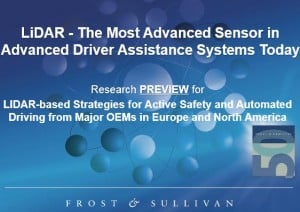 Frost and Sullivan reports that Light Detection and Ranging (LiDAR) technology, as part of an advanced driver assistance system (ADAS) sensor suite, will be mostly deployed for active safety functions with only 29 percent fitted for fully automated driving purposes by 2021. Out of the top 13 original equipment manufacturers (OEMs), 7 are working on automated driving passenger vehicles using a LiDAR.
Frost and Sullivan reports that Light Detection and Ranging (LiDAR) technology, as part of an advanced driver assistance system (ADAS) sensor suite, will be mostly deployed for active safety functions with only 29 percent fitted for fully automated driving purposes by 2021. Out of the top 13 original equipment manufacturers (OEMs), 7 are working on automated driving passenger vehicles using a LiDAR.
The new analysis from Frost & Sullivan, found that the LiDAR-enabled passenger vehicle market earned revenues of $51.1 million in 2014 and estimates this to reach $141.0 million in 2021.
North America is expected to be the launch pad of automated driving technology. The top three German OEMs will have almost 2 million passenger vehicles with automated capabilities on the road by 2021.
The need to deploy improved sensors that support active safety and automated driving in future passenger vehicles has driven the European and North American automotive industry towards exploring LiDAR technology. Compared to other products on the market, LiDAR is a better sensor in terms of object detection and mapping in low-visibility conditions, notes the report. The use of reflective infrared lasers to capture data and the independence from ambient light enables LiDAR to perceive objects the same way in a wide range of conditions.
The European and North American markets do offer some cost-effective LiDAR solutions but they have a resolution that is poor-to-modest at best. Reliability issues also plague these systems as they consist of a few moving parts.
Other problems associated with LiDAR systems are its limited range and packaging constraints. The average LiDAR system available on the market can scan up to 100 meters ahead with limited reflectivity. This, however, is inferior to camera-based systems, which provide a range up to 500 meters.
Original equipment manufacturers (OEMs) in Europe and North America are rigorously working with tier-one suppliers to create an advanced LiDAR solution for use in passenger vehicles. Those OEMs tying up with tier-one suppliers to develop LiDAR systems for automated driving vehicles will manage successful and faster introduction of their products.
For complimentary access to more information on this research, please visit: http://corpcom.frost.com/forms/EU_PR_KFeick_MB42-18_03Sep15.